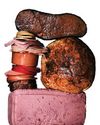What happens when illnness becomes an identity?
Among the symptoms that chronic-Lyme patients describe, “brain fog” is the one everyone talks about: trouble thinking and focusing, forgetfulness, confusion. There’s fatigue, the kind of exhaustion that might make it feel too arduous to get out of bed. Then there’s pain—headaches, joint pain, muscle pain, pain that won’t go away. Or maybe the pain does go away—it comes and goes. Or maybe there’s nausea. Or your eyes hurt. Or you’ve got panic attacks, or bladder issues

Polly Murray, in the 1960s and ’70s, was a mother of four with an old house on several acres in Lyme, Connecticut. In the summer, her kids built forts in the woods; they ice-skated on frozen cow ponds in the winter. The Murrays had an idyllic life in the country. They also had enormous rashes, strange joint swellings, and recurrent fevers.
One son wound up in the infirmary at boarding school, unable to lift his leg. Another had to have the fluid drained from his knee. Murray was constantly taking herself or her husband or one of her kids to a doctor—but none of the doctors ever had answers, nor did they seem especially interested in finding any. So Murray took the search upon herself. In The Widening Circle, her 1996 memoir, she reproduces extracts from her diary (“Monday, July 28: Todd had a fever of 100 again for two days and a severe jaw ache; he said it hurt to open his mouth … The attack lasted for five days”). The record Murray gathered is a testament to both the relentlessness of the symptoms and her own relentlessness in tracking them. Her husband compares her to “the lonely hero of a Hitchcock movie”: isolated, embattled, and disbelieved.
Soon, though, Murray started to hear other stories like hers. Her area, it appeared, had a cluster of juvenile-rheumatoid-arthritis cases. She called the state’s health department and met with Dr. Allen Steere, a rheumatologist doing a fellowship at Yale. He pored over her pages of notes. On the car ride home, Murray wept with joy: Steere didn’t have any answers, but he had listened. He wanted to find out what was wrong. By 1976, the condition Murray had observed had become known as Lyme disease.
Diese Geschichte stammt aus der July 22 - August 4, 2019-Ausgabe von New York magazine.
Starten Sie Ihre 7-tägige kostenlose Testversion von Magzter GOLD, um auf Tausende kuratierte Premium-Storys sowie über 8.000 Zeitschriften und Zeitungen zuzugreifen.
Bereits Abonnent ? Anmelden
Diese Geschichte stammt aus der July 22 - August 4, 2019-Ausgabe von New York magazine.
Starten Sie Ihre 7-tägige kostenlose Testversion von Magzter GOLD, um auf Tausende kuratierte Premium-Storys sowie über 8.000 Zeitschriften und Zeitungen zuzugreifen.
Bereits Abonnent? Anmelden

Trapped in Time
A woman relives the same day in a stunning Danish novel.

Polyphonic City
A SOFT, SHIMMERING beauty permeates the images of Mumbai that open Payal Kapadia's All We Imagine As Light. For all the nighttime bustle on display-the heave of people, the constant activity and chaos-Kapadia shoots with a flair for the illusory.

Lear at the Fountain of Youth
Kenneth Branagh's production is nipped, tucked, and facile.

A Belfast Lad Goes Home
After playing some iconic Americans, Anthony Boyle is a beloved IRA commander in a riveting new series about the Troubles.

The Pluck of the Irish
Artists from the Indiana-size island continue to dominate popular culture. Online, they've gained a rep as the \"good Europeans.\"

Houston's on Houston
The Corner Store is like an upscale chain for downtown scene-chasers.

A Brownstone That's Pink Inside
Artist Vivian Reiss's Murray Hill house of whimsy.

These Jeans Made Me Gay
The Citizens of Humanity Horseshoe pants complete my queer style.

Manic, STONED, Throttle, No Brakes
Less than six months after her Gagosian sölu show, the artist JAMIAN JULIANO-VILLAND lost her gallery and all her money and was preparing for an exhibition with two the biggest living American artists.

WHO EVER THOUGHT THAT BRIGHT PINK MEAT THAT LASTS FOR WEEKS WAS A GOOD IDEA?
Deli Meat Is Rotten